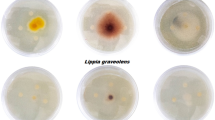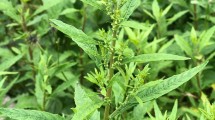Abstract
Essential oils (EOs) and oleoresins are complex mixtures mainly made up of terpenes, synthesized by a wide variety of plants. Individual terpenes may show broad-spectrum activity against different plant pathogens, and their combination into EO and oleoresin mixtures enhances plant chemical defense. The interest in EOs has significantly increased due to the trend of using natural products as herbicides, insecticidal and antimicrobial agents. In addition, the use of plant mixtures is an emerging approach to face the problem of antimicrobial resistance in agriculture. This chapter reports guidelines about plant sample collection for the production of EOs and provides protocols to test their activity as antimicrobial agents against bacteria and fungi. It also describes a solvent-free method for the inclusion of EOs into β-cyclodextrins. This type of formulate is prepared to turn liquid EOs into easily manageable water-soluble powders, and to control the release of volatile compounds, aiming to increase EOs' applications in agriculture.
Access this chapter
Tax calculation will be finalised at checkout
Purchases are for personal use only
Similar content being viewed by others
References
Dhifi W, Bellili S, Jazi S et al (2016) Essential oils’ chemical characterization and investigation of some biological activities: a critical review. Medicines (Basel) 3:25
Zhou F, Pichersky E (2020) More is better: the diversity of terpene metabolism in plants. Curr Opin Plant Biol 55:1–10
Langenheim JH (1994) Higher plant terpenoids: a phytocentric overview of their ecological roles. J Chem Ecol 20(6):1223–1280
Croteau R, Kutchan TM, Lewis NG (2000) Secondary metabolites – Chap 24. In: Biochemistry & molecular biology of plants. American Society of Plant Physiologists, pp 1250–1318
Hartmann T (1996) Diversity and variability of plant secondary metabolism: a mechanistic view. Entomol Exp Appl 80:177–188
Gershenzon J, Dudareva N (2007) The function of terpene natural products in the natural world. Nat Chem Biol 3:408–414
Franz C, Novak J (2010) Sources of essential oils. In: Baser KHC, Buchbauer G (eds) Handbook of essential oils: science, technology, and applications. CRC Press/Taylor & Francis Group, Boca Raton, pp 39–82
Phillips MA, Croteau RB (1999) Resin-based defenses in conifers. Trends Plant Sci 4:184–190
Cates RG (1996) The role of mixtures and variation in the production of terpenoids in conifer-insect-pathogen interactions. In: Romeo JT, Saunders JA, Barbosa P (eds) Phytochemical diversity and redundancy in ecological interactions. Recent advances in phytochemistry, vol 30. Springer, Boston. https://doi.org/10.1007/978-1-4899-1754-6_7
Mehdizadeh L, Moghaddam M (2018) Essential oils: biological activity and therapeutic potential. In: Therapeutic, probiotic, and unconventional foods. Academic Press, pp 167–179
Dagli N, Dagli R, Mahmoud RS et al (2015) Essential oils, their therapeutic properties, and implication in dentistry: a review. J Int Soc Prev Community Dent 5(5):335–340. https://doi.org/10.4103/2231-0762.165933
Edris AE (2007) Pharmaceutical and therapeutic potentials of essential oils and their individual volatile constituents: a review. Phytother Res 21(4):308–323
Knobloch K, Pauli A, Iberl B et al (1989) Antibacterial and antifungal properties of essential oil components. J Essent Oil Res 1(3):119–128
Ghavam M, Manca ML, Manconi M et al (2020) Chemical composition and antimicrobial activity of essential oils obtained from leaves and flowers of Salvia hydrangea DC. ex Benth. Sci Rep 10(1):1–10
Rossiter SE, Fletcher MH, Wuest WM (2017) Natural products as platforms to overcome antibiotic resistance. Chem Rev 117(19):12415–12474
Salem N, Kefi S, Tabben O, Ayed A, Jallouli S, Feres N, Hammami M, Khammassi S, Hrigua I, Nefisi S, Sghaier A, Limam S, Elkahoui S (2018) Variation in chemical composition of Eucalyptus globulus essential oil under phenological stages and evidence synergism with antimicrobial standards. Ind Crop Prod 124:115–125
Omonijo FA, Ni L, Gong J et al (2018) Essential oils as alternatives to antibiotics in swine production. Anim Nutr 4:126–136
Isman MB (2000) Plant essential oils for pest and disease management. Crop Prot 19:603–608
Kotan R, Dadasoĝlu F, Karagoz K et al (2013) Antibacterial activity of the essential oil and extracts of Satureja hortensis against plant pathogenic bacteria and their potential use as seed disinfectants. Sci Hortic 153:34–41
De Mastro G, El Mahdi J, Ruta C (2021) Bioherbicidal potential of the essential oils from Mediterranean lamiaceae for weed control in organic farming. Plants (Basel) 10:818
Mena P, Galindo A, Collado-González J et al (2013) Sustained deficit irrigation affects the colour and phytochemical characteristics of pomegranate juice. J Sci Food Agric 93:1922–1927
Menicucci F, Michelozzi M, Raio A et al (2021) Thymol-loaded lipid nanovectors from the marine microalga Nannochloropsis sp. as potential antibacterial agents. Biocatal Agric Biotechnol 32:101962
Sarwar M, Salman M (2015) Toxicity of oils formulation as a new useful tool in crop protection for insect pests control. Int J Chem Biomol Sci 1:297–302
Sharma A, Dubey S, Iqbal N (2020) Microemulsion formulation of botanical oils as an efficient tool to provide sustainable agricultural Pest management. In: Nano-and microencapsulation-techniques and applications. IntechOpen. https://doi.org/10.5772/intechopen.91788
Tanovic B, Gasic S, Hrustic J et al (2013) Development of a thyme essential oil formulation and its effect on Monilinia fructigena. Pestic Phytomed (Belgrade) 28(4):273–280. https://doi.org/10.2298/PIF1304273T
Wadhwa G, Kumar S, Chhabra L et al (2017) Essential oil–cyclodextrin complexes: an updated review. J Incl Phenom Macrocycl Chem 89:39–58
Squillace AE (1976) Analyses of monoterpenes of conifers by gas-liquid chromatography. In: Miksche JP (ed) Modern methods in forest genetics. Proceedings in life sciences. Springer, Berlin, Heidelberg
Akbar S (2020) Taxus baccata L. (Taxaceae). In: Handbook of 200 medicinal plants. Springer, Cham, pp 1753–1761
Hanover JW (1992) Applications of terpene analysis in forest genetics. New For 6(1–4):159–178
Baradat P, Marpeau A, Walter J (1991) Terpene markers. In: Muller-Starck G, Ziehe M (eds) Genetic variation in European populations of forest trees. Sauerlander’s Verlag, Frankfurt am Main, pp 40–66
Barbero F, Maffei M (2016) Biodiversity and chemotaxonomic significance of specialized metabolites. In: Plant specialized metabolism. CRC Press, pp 35–76
Nikolić JS, Zlatković BK, Jovanović S et al (2021) Needle volatiles as chemophenetic markers in differentiation of natural populations of Abies alba, A. x borisii-regis, and A. cephalonica. Phytochemistry 183:112612
Michelozzi M, Tognetti R, Maggino F et al (2008) Seasonal variations in monoterpene profiles and ecophysiological traits in Mediterranean pine species of group “halepensis”. iForest Biogeosci For 1(1):65
EUCAST Definitive Document (1998) Methods for the determination of susceptibility of bacteria to antimicrobial agents. Terminology. Clin Microbiol Infect 4:291–296
Acheampong A, Borquaye LS, Acquaah SO et al (2015) Antimicrobial activities of some leaves and fruit peels hydrosols. Int J Chem Biomol Sci 1:158–162
Di Vito M, Bellardi MG, Mondello F et al (2019) Monarda citriodora hydrolate vs essential oil comparison in several anti-microbial applications. Ind Crop Prod 128:206–212
Author information
Authors and Affiliations
Corresponding author
Editor information
Editors and Affiliations
Rights and permissions
Copyright information
© 2022 The Author(s), under exclusive license to Springer Science+Business Media, LLC, part of Springer Nature
About this protocol
Cite this protocol
Menicucci, F. et al. (2022). Plant Sampling for Production of Essential Oil and Evaluation of Its Antimicrobial Activity In Vitro. In: Luchi, N. (eds) Plant Pathology. Methods in Molecular Biology, vol 2536. Humana, New York, NY. https://doi.org/10.1007/978-1-0716-2517-0_28
Download citation
DOI: https://doi.org/10.1007/978-1-0716-2517-0_28
Published:
Publisher Name: Humana, New York, NY
Print ISBN: 978-1-0716-2516-3
Online ISBN: 978-1-0716-2517-0
eBook Packages: Springer Protocols




